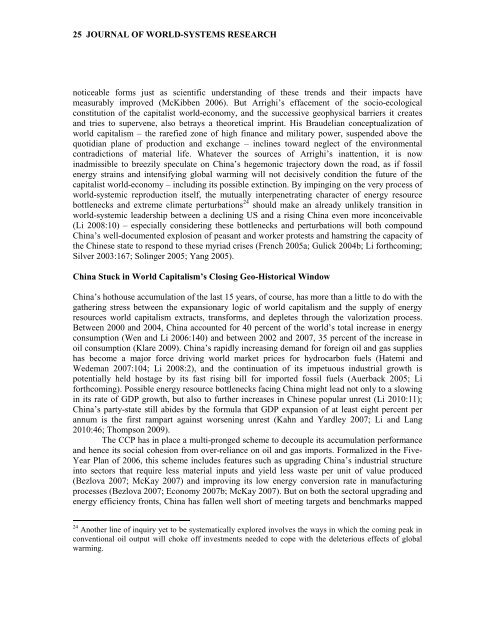Entire Volume 17 issue 1 - Journal of World-Systems Research ...
Entire Volume 17 issue 1 - Journal of World-Systems Research ...
Entire Volume 17 issue 1 - Journal of World-Systems Research ...
You also want an ePaper? Increase the reach of your titles
YUMPU automatically turns print PDFs into web optimized ePapers that Google loves.
25 JOURNAL OF WORLD-SYSTEMS RESEARCH<br />
noticeable forms just as scientific understanding <strong>of</strong> these trends and their impacts have<br />
measurably improved (McKibben 2006). But Arrighi’s effacement <strong>of</strong> the socio-ecological<br />
constitution <strong>of</strong> the capitalist world-economy, and the successive geophysical barriers it creates<br />
and tries to supervene, also betrays a theoretical imprint. His Braudelian conceptualization <strong>of</strong><br />
world capitalism – the rarefied zone <strong>of</strong> high finance and military power, suspended above the<br />
quotidian plane <strong>of</strong> production and exchange – inclines toward neglect <strong>of</strong> the environmental<br />
contradictions <strong>of</strong> material life. Whatever the sources <strong>of</strong> Arrighi’s inattention, it is now<br />
inadmissible to breezily speculate on China’s hegemonic trajectory down the road, as if fossil<br />
energy strains and intensifying global warming will not decisively condition the future <strong>of</strong> the<br />
capitalist world-economy – including its possible extinction. By impinging on the very process <strong>of</strong><br />
world-systemic reproduction itself, the mutually interpenetrating character <strong>of</strong> energy resource<br />
bottlenecks and extreme climate perturbations 24<br />
should make an already unlikely transition in<br />
world-systemic leadership between a declining US and a rising China even more inconceivable<br />
(Li 2008:10) – especially considering these bottlenecks and perturbations will both compound<br />
China’s well-documented explosion <strong>of</strong> peasant and worker protests and hamstring the capacity <strong>of</strong><br />
the Chinese state to respond to these myriad crises (French 2005a; Gulick 2004b; Li forthcoming;<br />
Silver 2003:167; Solinger 2005; Yang 2005).<br />
China Stuck in <strong>World</strong> Capitalism’s Closing Geo-Historical Window<br />
China’s hothouse accumulation <strong>of</strong> the last 15 years, <strong>of</strong> course, has more than a little to do with the<br />
gathering stress between the expansionary logic <strong>of</strong> world capitalism and the supply <strong>of</strong> energy<br />
resources world capitalism extracts, transforms, and depletes through the valorization process.<br />
Between 2000 and 2004, China accounted for 40 percent <strong>of</strong> the world’s total increase in energy<br />
consumption (Wen and Li 2006:140) and between 2002 and 2007, 35 percent <strong>of</strong> the increase in<br />
oil consumption (Klare 2009). China’s rapidly increasing demand for foreign oil and gas supplies<br />
has become a major force driving world market prices for hydrocarbon fuels (Hatemi and<br />
Wedeman 2007:104; Li 2008:2), and the continuation <strong>of</strong> its impetuous industrial growth is<br />
potentially held hostage by its fast rising bill for imported fossil fuels (Auerback 2005; Li<br />
forthcoming). Possible energy resource bottlenecks facing China might lead not only to a slowing<br />
in its rate <strong>of</strong> GDP growth, but also to further increases in Chinese popular unrest (Li 2010:11);<br />
China’s party-state still abides by the formula that GDP expansion <strong>of</strong> at least eight percent per<br />
annum is the first rampart against worsening unrest (Kahn and Yardley 2007; Li and Lang<br />
2010:46; Thompson 2009).<br />
The CCP has in place a multi-pronged scheme to decouple its accumulation performance<br />
and hence its social cohesion from over-reliance on oil and gas imports. Formalized in the Five-<br />
Year Plan <strong>of</strong> 2006, this scheme includes features such as upgrading China’s industrial structure<br />
into sectors that require less material inputs and yield less waste per unit <strong>of</strong> value produced<br />
(Bezlova 2007; McKay 2007) and improving its low energy conversion rate in manufacturing<br />
processes (Bezlova 2007; Economy 2007b; McKay 2007). But on both the sectoral upgrading and<br />
energy efficiency fronts, China has fallen well short <strong>of</strong> meeting targets and benchmarks mapped<br />
24 Another line <strong>of</strong> inquiry yet to be systematically explored involves the ways in which the coming peak in<br />
conventional oil output will choke <strong>of</strong>f investments needed to cope with the deleterious effects <strong>of</strong> global<br />
warming.





